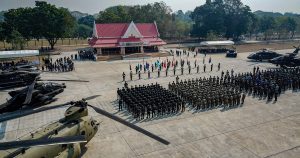The M4 rifle has long been a staple of the United States armed forces, representing a significant upgrade over its predecessor, the M16—an important weapon in the fight against terrorism.

PUCKAPUNYAL, AustraliaÑSgt. Jonathan Shue, machine shop noncommissioned officer-in-charge, Marine Aviation Logistics Squadron 36, Marine Air Group 36, 1st Marine Aircraft Wing, III Marine Expeditionary Force, shoots his M4 carbine here May 10 at the 2011 Australian Army Skill at Arms Meeting. The meeting is an annual, international combat marksmanship competition hosted by the Australian Army that will be held through May 19. (U.S. Marine Corps Photo by Lance Cpl. Mark W. Stroud/Released)
“The adage “bigger is better” is not always correct. Moreover, the M4 carbine and its variations, like the M4A1, epitomise this truth, as they have proven wildly popular as the offspring of the larger-calibre M16 rifle series from which they descended.
The M4 wasn’t the first shortened variant of the M16; the CAR-15 (also known as the Colt Commando) appeared in the mid-1960s, and the GUU-5/P was issued to some U.S. Air Force forces in the 1990s.
Nonetheless, it was the M4 that ultimately paved the way for the M16/AR-15 series’ small variant to become a standard issue in the United States Armed Services. Allow me to explain how and why.
Curiously, the first development contract for the XM4 carbine was awarded to Colt in 1984 for use by ponies, er, and non-infantry personnel; by 1986, the prototypes had been given to the U.S. Army for testing.
After nearly an additional decade of design refinement and approval, the U.S. Department of Defense finally put the M4 and M4A1 carbines into service in 1994.
However, it wasn’t until the post-9/11 era and the accompanying Global War on Terror (GWOT) that the M4 took off; after all, that compactness came in handy when hunting Taliban and al-Qaeda bad guys within the daunting confines of the caves of Afghanistan and when fighting insurgents in house-to-house firefights during Operation Iraqi Freedom.
It implemented several upgrades to the primary weapon due to feedback from the troops in after-action reports from these battlefields. The heavier barrel, in particular, is more reliable and durable over the long run as it can endure prolonged and severe shooting.
Although the smaller weapon had a lower effective range and less lethality or stopping power than its full-sized parent gun, the Army, Air Force, and Marine Corps all agreed that this was a fair tradeoff to make in exchange for the weapon’s increased portability and usefulness in close-quarters combat (CQB).
One Ranger squad in Afghanistan in 2013 caused a stir when they opted not to bring the cutting-edge XM25 25x40mm semiautomatic grenade launcher.
The M4 is somewhat interchangeable with the M16 due to the M16 serving as the basis for about 80% of the M4’s design. It is How Your Tax Funds Are Being Used. The 14.5-inch barrel and telescoping shoulder stock are the main distinctions. The internals of the M4 carbine comprise the following to provide a steady supply:
- A modified bolt carrier buffer.
- A shorter gas system.
- A feed ramp is cut into the barrel extension and the receiver.
Furthermore, except for the first production run, nearly all M4 carbines feature so-called “flattop” receivers with integrated Picatinny rails, which have supplanted the M16A2-style carrying handle.
I’m not a big admirer of the AR-15 family of firearms, so I don’t own an M4 or any other model and have no plans to get one anytime soon. Although lightweight and accurate, the Avtomat Kalashnikova, SKS carbine, Vz-58, and 7.62x39mm ammunition are all superior due to their ease of use, low maintenance requirements, and reliability. (Go ahead and make your “Russian collusion” jokes about that admission; I can take it.) Yet, I still spent a lot of time behind the M4’s trigger as an Air Force cop and later as a very dirty, stinkin’ mercenary, um, privateer, er, private military contractor (PMC).
I remember, as an Airman 1st Class/E-3 in the United States Air Force from February 2000 to July 2001, how much I longed for the shorter and sweeter compactness of the M4 while carrying a full-sized M16A2 around the tight confines of the Missile Alert Facilities (MAFs) of the “Nuke-yu-lur,” er, nuclear missile fields of Minot AFB, North Dakota. Better late than never, but it wasn’t until I sold my soul to the dark side, graduated from Officer Training School (OTS), and left the missile fields behind that my wish came true. While I regularly qualified with the more coveted weapon, I never shot Expert with it as I did with the full-sized A2. They say that’s life, so what can you do?






